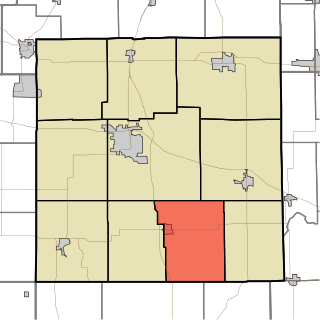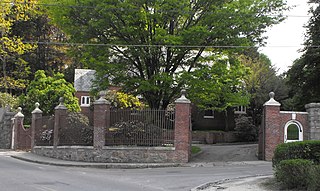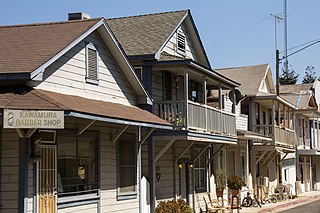
Walnut Canyon National Monument is a United States National Monument located about 10 mi (16 km) southeast of downtown Flagstaff, Arizona, near Interstate 40. The canyon rim elevation is 6,690 ft (2,040 m); the canyon's floor is 350 ft lower. A 0.9 mi (1.4 km) long loop trail descends 185 ft (56 m) into the canyon passing 25 cliff dwelling rooms constructed by the Sinagua, a pre-Columbian cultural group that lived in Walnut Canyon from about 1100 to 1250 CE. Other contemporary habitations of the Sinagua people are preserved in the nearby Tuzigoot and Montezuma Castle national monuments.

High Point Terrace is a neighborhood located in the heart of the city of Memphis, Tennessee.

The Cyrus McCormick Farm and Workshop is on the family farm of inventor Cyrus Hall McCormick known as Walnut Grove. Cyrus Hall McCormick improved and patented the mechanical reaper, which eventually led to the creation of the combine harvester. The farm is near Steele's Tavern and Raphine, close to the northern border of Rockbridge and Augusta counties in the U.S. state of Virginia, and is currently a museum run by the Virginia Agricultural Experimental Station of Virginia Tech. The museum with free admission and covers 5 acres (2.0 ha) of the initial 532-acre (215.3 ha) farm.

Walnut Grove Plantation, the home of Charles and Mary Moore, was built in 1765 on a land grant given by King George III. The property is located in Roebuck in Spartanburg, South Carolina. Charles Moore was a school teacher and used the 3,000-acre (12 km2) plantation as a farm. The Moores had ten children, and some of their descendants still live within the area.

Walnut Township is one of ten townships in Marshall County, Indiana, United States. As of the 2010 census, its population was 2,747 and it contained 1,124 housing units.

Shotwell is an unincorporated community in rural eastern Wake County, North Carolina, United States, located about 4 miles (6.4 km) south of Knightdale and 11 miles (18 km) east of Raleigh at the confluence of Smithfield, Mial Plantation, Major Slade, Grasshopper, and Turnipseed Roads. Shotwell has been inhabited since the early 19th century and is home to a number of historic structures. A post office was established in 1883 but closed less than two decades later.

Walnut Grove Cemetery is a historic cemetery at Grove and Railroads Streets in Methuen, Massachusetts. The still active cemetery sits on 14 acres (5.7 ha) and is privately funded with a Board of Directors. The cemetery was established in 1853, and was laid out in the then-popular rural cemetery style. The Tenney Memorial Chapel given by the Daniel G. Tenney in 1927 as a memorial to his parents Charles H. Tenney and Fannie Haseltine (Gleason) Tenney. The chapel was designed by architect Grosvenor Atterbury. The earliest burial is estimated to be about 1850; whereas the number of burials before 1960 is unknown, there have been 896 burials since 1960.

Walnut Hills Cemetery is a historic cemetery on Grove Street and Allandale Road in Brookline, Massachusetts. It encompasses 45.26 acres (18.32 ha), with mature trees and puddingstone outcrops, and was laid out in 1875 in the then-fashionable rural cemetery style. Many past prominent citizens of the town, including architect H.H. Richardson, are buried here. The cemetery was listed on the National Register of Historic Places in 1985.

Old Providence Stone Church is a historic church in Spottswood, Virginia in Augusta County, Virginia.

Walnut Grove is an historic Greek Revival-style house in Spotsylvania County, Virginia. The house was built in 1840 on land that was purchased by Jonathan Johnson in 1829. Markings on the exposed oak beams indicate that Walnut Grove was built by William A. Jennings. Jennings was recognized as a master builder of Greek Revival homes during that period. Walnut Grove was added to the National Register of Historic Places in August 2004.

Henry C. Lea Elementary School is a historic elementary school located in the Walnut Hill neighborhood of Philadelphia, Pennsylvania. It is part of the School District of Philadelphia. The building was designed by Henry deCourcy Richards and built by Cramp & Co. in 1914. It is a three-story, five bay, reinforced concrete building faced with brick and with terra cotta and granite trim in the Late Gothic Revival-style. It sits on a raised basement. It features a Classical limestone center entrance surround, a central two-story bay window, decorative panels, crenelated parapet, and a projecting entrance bay. It was used as an "observation school" for teacher education and training.

The Walnut Hill Historic District is a collection of 40 family dwellings, agricultural outbuildings, and other structures and sites associated with the Walnut Hill Plantation and the Mial-Williamson and Joseph Blake farms near Shotwell, North Carolina. The historic district represents the post-Civil War growth of one of the largest agricultural centers in Wake County. It is situated primarily along the northeast end of Mial Plantation Road between its intersections with Major Slade and Smithfield Roads.

Walnut Grove Methodist Church is a historic church in rural western Pulaski County, Arkansas. It is located southwest of Little Rock, on the east side of Walnut Grove Road between County Roads 38 and 31. It is a modest single-story wood frame structure, with a gabled roof, rough-cut clapboard siding, and vernacular Greek Revival detailing. Its interior is finished with wooden planking, and it retains original period pews of similarly simple construction. Built in 1885, it is the oldest church in Pulaski County.

The Grove, also known as The Children's Advocacy Center of Bristol and Washington County, is a historic home located just outside Bristol in Washington County, Virginia. It was built in 1857, on the Walnut Grove tract. It is a two-story, five-bay, brick Greek Revival style dwelling with a kitchen wing. The house has a gable roof and features a two-story wood framed front porch.

Walnut Grove, also known as the Robert Preston House, is a historic plantation house located just outside Bristol in Washington County, Virginia. It was built about 1815, and is a two-story, Georgian style timber-frame dwelling covered with wood weatherboard. The house has a gable roof and has a one-story full-width porch. The Grove was built on the Walnut Grove property in 1857.

Walnut Grove is a historic house on a Southern plantation in Mount Pleasant, Maury County, Tennessee, USA.

The Walnut Grove Cemetery is a historic cemetery in rural Independence County, Arkansas, on Walden Road, just north of Arkansas Highway 25, northwest of Cord. Established in 1840, it is one of the oldest cemeteries in the area, set on what was once the only major roadway through the region. It is the only significant surviving element of the community of Walnut Grove, which was located at a locally important crossroads in the 19th century.

Walnut Grove School is a historic one-room schoolhouse located southwest of Osage in rural Mitchell County, Iowa, United States. It was in operation from 1857 to 1946, and it educated anywhere from five to thirty-three student at a time. The frame structure built on a limestone foundation was constructed in 1873 on the same site as the building it replaced. A bell tower with a cast iron bell is located on the gable roof above the main entrance. Its property is on the edge of a timber along Rock Creek. In 1911 there were 88 one-room school houses in Mitchell County. This is the only one that is unaltered and in its original location. The area was settled by Norwegian pioneers in 1853. They named their small town Meroa, which has been reduced to his old schoolhouse, a Lutheran church, a cemetery, and a few houses. The building was listed on the National Register of Historic Places in 2002.

The Walnut Grove Japanese-American Historic District is a 5-acre (2.0 ha) designated U.S. Historic District in Walnut Grove, California. The bulk of Walnut Grove's Japantown was built in 1915–16 following the 1915 fire which destroyed Walnut Grove's Chinatown. Japantown was depopulated during the forced incarceration of Japanese and Japanese-Americans following the issuance of Executive Order 9066 in 1942, and was re-filled by Filipino and Mexican laborers, who took over work in local orchards and farms during the war. Although the original residents returned to Walnut Grove following the end of World War II, most left within a few years, and the district, with some exceptions, to this day retains the original architecture and style dating back to the 1916 reconstruction.

The Walnut Grove is a historic mansion in Gallatin, Tennessee, U.S.. It was built circa 1800, and expanded in the 1820s. The original owner was Charles Elliott, and his brother Elliott lived at Wall Spring nearby. It includes a portico, and a staircase designed in the Federal style. It has been listed on the National Register of Historic Places since December 29, 1978.






















